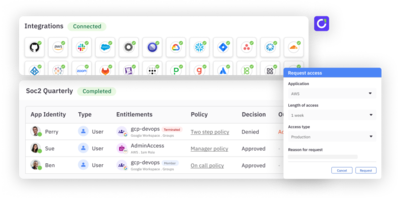Is Your IAM Ready? Rethinking Security for AI in Identity & Access Management
Artificial intelligence is reshaping the fabric of work. AI agents automate tasks, make decisions, and integrate deeply into core business workflows, becoming key actors within organizations. While these agents unlock massive productivity, they also introduce an entirely new class of identity: non-human, ephemeral, and proliferating by the thousands.
The widespread adoption of AI introduces significant security challenges, specifically for identity and access management (IAM) and traditional identity governance and administration (IGA) frameworks. Without proper management, the risk of unauthorized access and new vectors for cyber threats increases exponentially.
Legacy IAM tools were built primarily for managing human identities. They assume predictable user lifecycles, static roles, and manual oversight. They weren’t designed to handle the unique characteristics, lifecycle, permissions, and autonomous nature of non-human identities, creating critical security gaps and impacting the overall security posture.
To govern this new class of identities, organizations need an entirely new ** ** identity security model—one that’s scalable and purpose-built for the age of AI.
Three main types of AI agents
Agentic AI is autonomous artificial intelligence that can perform tasks, make decisions, and interact with systems or data on behalf of the organization or individual users.
AI agents show up in three core forms, each with unique implications for identity management.
Company AI agents
- Definition: These are typically system-wide agents embedded within specific business applications (like your CRM, code repository, or ERP system). They act autonomously on behalf of the organization itself.
- Examples:
- AI agent within Salesforce that proactively analyze and qualify leads
- GitHub’s AI agent that automatically reviews code submissions for potential issues
- Function: They often function like significantly more intelligent and autonomous versions of traditional service accounts, executing predefined workflows and interacting within the boundaries of their host application.
- Key characteristics:
- Act as organizational representatives within specific applications
- Execute automated workflows based on application data and logic
- Operate with defined permissions within their application’s ecosystem
- Can multiply quickly, as each new SaaS tool might introduce its own agent(s) in various deployments
- Risks: Company AI agents pose significant risks if granted excessive permissions, potentially leading to large-scale automation failures or data misuse.
Employee AI agents
- Definition: Unlike company agents tied to one application, employee AI agents work across multiple tools and systems, acting directly on behalf of an individual user to boost their productivity.
- Examples: An agent helping an employee draft emails by pulling information from various documents, summarizing research reports from multiple sources, or automating multistep tasks involving different applications based on learned user behavior.
- Function: They serve as personal digital assistants, aiming to streamline individual workflows.
- Key characteristics:
- Increase individual efficiency by automating tasks and synthesizing information
- Operate across different applications as a proxy for the user
- Risks: Employee AI agents often inherit the permissions of the user they serve, creating immediate security challenges if not carefully managed. This necessitates new access control models and security measures, requiring users (and the organization) to manage exactly what permissions their personal agents have.
Agent-to-agent interactions
- Definition: This is the most complex category, involving multiple AI agents communicating, negotiating, and making decisions directly with each other, often without real-time human intervention.
- Example: Imagine a company AI agent in the finance system communicating with another in the CRM to automatically validate contract terms and trigger a payment only when conditions are met by both systems.
- Function: Enables potentially seamless, high-speed, machine-driven automation across different business functions, significantly improving operational efficiency.
- Key characteristics: Allow complex cross-system workflows without human bottlenecks.
- Risks: Agent-to-agent interactions can raise major security, compliance, and auditing questions, such as:
- How are inter-agent decisions tracked and verified?
- Who is accountable for the interactions?
They introduce complex data flow and authorization challenges, as trust and permissions must be established dynamically between interacting agents. Each type of AI agent presents fundamentally different scenarios and risks for identity and access management, challenging traditional security approaches in unique ways and potentially opening avenues for new security threats.
Why legacy IAM can’t handle AI agents: three core conflicts
Traditional and legacy IAM systems were designed primarily around managing human user identities. This human-centric model makes several assumptions that AI agents break:
- Identity lifespan: Legacy IAM assumes relatively static identities with predictable lifecycles (onboarding, role changes, and offboarding, over months or years). AI agents, however, are often ephemeral, potentially existing only for minutes or seconds to complete a single task, rendering traditional lifecycle management processes inadequate.
- Access needs: Human access is often managed via broader roles that accumulate over time. AI agents typically require narrow, task-specific permissions granted dynamically and just-in-time. Applying broad human roles to agents often results in excessive, unnecessary privileges.
- Autonomy and speed: IAM often incorporates human oversight and manual approvals for requests. AI agents operate autonomously at machine speed, making real-time decisions without human intervention. Manual IAM processes simply cannot keep pace.
- Interaction models: IAM focuses on user-to-system access. AI agents introduce complex agent-to-agent interaction models, requiring secure communication and authorization frameworks that legacy systems lack.
This fundamental mismatch manifests in several critical IAM problems.
1. Getting permissions right
Traditional role-based access control (RBAC) struggles with AI agents. Granting broad roles creates excessive risk, while defining granular, task-specific access for dynamic agents is operationally complex with current tools.
Key issues include:
- Inherited over-privilege: Employee agents frequently inherit their user’s full permissions, vastly exceeding minimal needs and elevating risk exposure.
- Lack of granularity: It’s difficult to enforce least privilege for agents requiring temporary, specific access, unlike the broader, more static permissions typical for human roles.
2. Securing agent communication
When AI agents must interact directly, traditional IAM lacks mechanisms to establish trust securely. This leads to critical gaps:
- Authentication failure: No standard, reliable methods exist for one agent to verify another agent’s identity before exchanging data or services.
- Authorization uncertainty: Securely determining and enforcing what specific actions or sensitive data one agent is permitted to request from another, especially across different systems, remains a major challenge.
3. Managing ephemeral and autonomous identities
Current identity governance (IGA) frameworks are ill-equipped for the unique nature of AI agents, resulting in significant oversight problems:
- Ephemeral lifecycle issues: Tracking, managing, and certifying access for potentially thousands of short-lived agent identities falls outside the scope of human-centric lifecycle processes.
- Auditing black holes: Monitoring and auditing high-speed, autonomous agent decision-making is extremely difficult, creating challenges for accountability, compliance (e.g., GDPR), and incident response remediation.
Attempting to manage AI agents with IAM tools designed for humans can result in a dangerous combination of excessive permissions, inadequate oversight, security gaps, and an inability to scale. While companies have spent decades refining human identity governance, the unique nature of AI agents demands entirely new approaches purpose-built for their speed, scale, and autonomy.
Adapting IAM for AI: Core requirements for modern identity governance
Given the fundamental conflicts between traditional IAM and the nature of AI agents, simply tweaking existing systems is insufficient. Organizations must proactively rethink identity governance and adopt new, AI-native models—essentially moving toward AI-driven IAM.
The goal is to allow AI agents secure access to the resources they need while ensuring robust oversight, control, and effective security measures.
This requires building frameworks based on several key requirements:
1. Secure and ephemeral credentialing
The common unsafe practice of using static credentials (like passwords or API keys stored insecurely, sometimes even in prompts) for AI agents is unsustainable. A modern approach requires:
- Short-lived, dynamic credentials: Instead of long-lasting secrets, agents should use credentials that are generated for a specific purpose and expire quickly, often after a single use.
- Dynamic authentication models: Verification should move beyond static secrets to methods that can dynamically authenticate an agent’s identity and context at the time of access.
2. Granular, task-based authorization
Traditional role-based access control (RBAC) grants overly broad permissions ill-suited for AI agents. AI-native authorization must be more precise:
- Task-specific permissions: Access should be granted based on the specific task the agent needs to perform, adhering strictly to the principle of least privilege.
- Context-aware policies: Permissions should adapt in real-time based on the current context (e.g., the data being accessed, the risk level of the operation).
- Machine-speed evaluation: Consider mechanisms, potentially using AI itself (trusted agents or AI algorithms), to evaluate access requests from other agents at machine speed, ensuring security without manual bottlenecks.
3. AI-native identity infrastructure
Just as cloud computing spurred new security tools, the rise of AI demands a new class of identity infrastructure specifically designed for non-human identities:
- Purpose-built identity providers (IDPs): Systems designed to handle the dynamic provisioning, management, and deprovisioning of potentially millions of ephemeral AI agent identities, enabling effective continuous monitoring.
- Standardized authentication claims: Developing and adopting standards for how AI agents represent their identity and permissions to ensure interoperability across different AI platforms and enterprise systems.
- Integration capabilities: Mechanisms for seamless integration with AI platforms and protocols (like potential model context protocols, or MCPs) enabling secure communication and data access for agents within enterprise applications.
Addressing AI-driven identity challenges isn’t a concern for the future—it’s an immediate necessity. Organizations need to act decisively to implement these AI-native identity governance principles.
This involves building secure authentication and authorization models tailored for agents and developing policies that enforce least privilege while maintaining clear audit trails.
Embracing this fundamental shift from human-centric paradigms is crucial for managing identity and security effectively in a future powered by autonomous AI agents.
Secure all your identities with ConductorOne
ConductorOne is the first multi-agent identity security platform designed for the AI era. We protect every identity—human, non-human—and help you automate, govern, and secure access at scale. Our AI-native platform empowers you to:
- Gain visibility: Get a complete, real-time view of access across people, systems, and non-human identities.
- Scale effortlessly: Automate governance workflows—without scaling headcount.
- Build for the future: Deploy ready-to-use AI agents, streamline operations, and prepare for the next wave of agentic automation.
The identity challenges of tomorrow are already here. ConductorOne delivers the automation, visibility, and control you need to stay ahead.
Book a demo today to see how ConductorOne can help you meet the age of AI.
FAQs
How does AI improve core identity management functions?
While we highlight the significant new security challenges agentic AI introduces, it’s true that AI in general also offers powerful capabilities to enhance traditional IAM functions. When implemented carefully, AI can make IAM more intelligent and proactive. Key improvements include:
- Smarter threat detection: AI algorithms analyze user behavior patterns across identities to spot subtle anomalies and deviations indicating threats (like sophisticated phishing attempts), often more accurately and with fewer false positives, reducing alert fatigue caused by human error in analysis.
- Advanced access governance: Machine learning assists in enforcing least privilege by analyzing actual access usage (role mining) and optimizing role assignments, enabling dynamic, risk-based access decisions.
- Better user experience: Features like adaptive authentication reduce unnecessary friction for legitimate users by adjusting security requirements based on real-time risk assessments.
- Increased efficiency: AI can help automate tasks like compliance reporting, access certifications, and aspects of user onboarding and offboarding.
So, while managing AI’s own identity risks is crucial, its application within IAM offers substantial benefits in security and efficiency.
What are some practical use cases for AI in IAM?
- Risk-based authentication (RBA): Assessing login context (location, device, time) to decide if multi-factor authentication (MFA) is needed, making logins smoother when risk is low.
- Anomaly detection: Flagging unusual user activities based on learned normal user behavior.
- Intelligent role mining: Analyzing existing access patterns across users to suggest more accurate and secure role definitions based on actual usage.
- Automated access reviews: Suggesting which access rights might be unnecessary based on usage data, streamlining the certification process for managers.
- Just-in-Time (JIT) access: Automatically providing temporary elevated permissions only for the duration needed to complete a specific task.
How does the concept of AI-native IAM relate to zero trust principles?
AI-native IAM is highly compatible with and essential for zero Trust. Zero trust demands continuous verification for all access requests and strict enforcement of least privilege. Since AI agents operate autonomously and can be ephemeral, traditional trust assumptions fail. AI-native IAM provides the necessary advanced mechanisms – like dynamic authentication, short-lived credentials, and context-aware, task-based authorization – needed to rigorously verify agent identities and enforce least privilege for every action, aligning perfectly with the core tenets of Zero Trust.
Beyond security risks, what are the biggest operational challenges in governing AI agents?
Operationally, key challenges beyond direct security breaches include:
- Scale and complexity: Managing potentially vast numbers of dynamic, interconnected agent identities and their permissions is extremely complex and overwhelms manual processes.
- Speed of change: AI agents and their capabilities can change rapidly, demanding equally agile governance frameworks.
- Lack of standardization: Different AI tools may use proprietary identity methods, hindering consistent policy enforcement and interoperability.
- Monitoring and auditing: Effectively tracking and understanding the actions of autonomous agents for operational oversight (not just security) is difficult.
- Skills gap: Teams need to develop new expertise to manage and govern AI identities effectively.
How can we mitigate the risk of AI agents inheriting privileged access or excessive user permissions?
This requires moving beyond simple inheritance. Strategies include:
- Task-based authorization: Implementing IAM solutions that allow granting permissions specifically for the tasks the agent performs, rather than mirroring the user’s full access.
- Context-aware policies: Using controls that limit agent actions based on context (e.g., sensitivity of data, target application).
- Agent permission management: Providing clear interfaces (governed by central policy) for users or managers to review and approve the specific entitlements their agents request or use.
- Purpose-built agent platforms: Utilizing platforms designed with secure permission delegation models for agents.
Are there emerging standards for AI agent identity and authentication?
As of early 2025, this field is still rapidly developing. There aren’t yet universal standards designed exclusively for AI agent identity like there are for human identities (e.g., SAML, OIDC in their original scope). However, existing standards are being explored and adapted, including:
- OAuth 2.0 for delegated authorization
- OpenID Connect (OIDC) for identity assertion
- Workload identity (like SPIFFE/SPIRE) for non-human entities
Expect standardization efforts to increase as AI agent use becomes more widespread and the need for secure interoperability grows.





